The “Network Security Breach” popup on your screen is just one of the many web-sites of the so-called misleading type. It’s made to fill the web-browser’s constant stream of fake alerts and warnings to force you into calling the fake Microsoft Support Service.
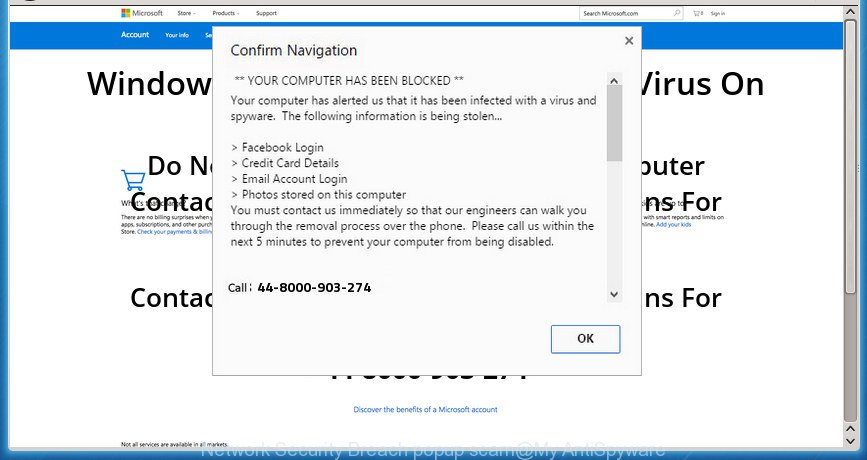
“Network Security Breach” is a misleading advertising
If your internet browser began rerouting to the “Network Security Breach” web page then it is possible that your web browser has been affected with the nasty malware from the adware family. The ad supported software is developed in order to display third-party advertisements to the user without asking his permission. The ‘ad supported’ software takes control of installed web browsers and redirects them to undesired web sites like the “Network Security Breach” every time you surf the Net.
In addition to that, as was mentioned earlier, some adware to also alter all web-browsers shortcut files that located on your Desktop or Start menu. So, every affected shortcut will try to redirect your browser to various ad web-sites including misleading ads like the “Network Security Breach” page, some of which might be harmful. It can make the whole PC more vulnerable to hacker attacks.
Instructions which is shown below, will allow you to clean your PC from the ad supported software as well as get rid of “Network Security Breach” unwanted pop-up advertisements from the Edge, IE, Chrome and Firefox and other web-browsers.
Remove “Network Security Breach” popup warnings (removal instructions)
Not all unwanted apps like adware which created to show misleading “Network Security Breach” pop-up scam within your web browser are easily uninstallable. You might see popups, deals, text links, in-text advertisements, banners and other type of advertisements in the Chrome, Internet Explorer, Edge and FF and might not be able to figure out the application responsible for this activity. The reason for this is that many unwanted applications neither appear in MS Windows Control Panel. Therefore in order to completely delete “Network Security Breach” fake alerts, you need to execute the following steps. Certain of the steps below will require you to shut down this web page. So, please read the steps carefully, after that bookmark or print it for later reference.
To remove “Network Security Breach”, use the following steps:
- Manual “Network Security Breach” fake alerts removal
- Deleting the “Network Security Breach”, check the list of installed applications first
- Remove “Network Security Breach” popup warnings from Internet Explorer
- Get rid of “Network Security Breach” from Firefox by resetting browser settings
- Remove “Network Security Breach” pop up from Chrome
- Disinfect the web-browser’s shortcuts to remove “Network Security Breach” redirect
- Remove unwanted Scheduled Tasks
- How to automatically get rid of “Network Security Breach” pop up warnings
- Block “Network Security Breach” pop-up warnings and other undesired web pages
- How to “Network Security Breach” popup warnings get installed onto personal computer
- Finish words
Manual “Network Security Breach” fake alerts removal
The following instructions is a step-by-step guide, which will help you manually get rid of “Network Security Breach” fake alerts from the IE, Chrome, Firefox and Edge.
Deleting the “Network Security Breach”, check the list of installed applications first
In order to get rid of PUPs like this ad supported software, open the MS Windows Control Panel and click on “Uninstall a program”. Check the list of installed software. For the ones you do not know, run an Internet search to see if they are adware, hijacker infection or potentially unwanted programs. If yes, uninstall them off. Even if they are just a apps that you do not use, then removing them off will increase your computer start up time and speed dramatically.
Windows 8, 8.1, 10
First, click the Windows button
Windows XP, Vista, 7
First, press “Start” and select “Control Panel”.
It will show the Windows Control Panel like below.

Next, press “Uninstall a program” ![]()
It will show a list of all programs installed on your PC system. Scroll through the all list, and delete any questionable and unknown software. To quickly find the latest installed applications, we recommend sort apps by date in the Control panel.
Remove “Network Security Breach” popup warnings from Internet Explorer
In order to restore all web-browser newtab, start page and search engine you need to reset the Internet Explorer to the state, that was when the Windows was installed on your PC.
First, open the IE, then click ‘gear’ icon ![]() . It will show the Tools drop-down menu on the right part of the web-browser, then press the “Internet Options” as displayed below.
. It will show the Tools drop-down menu on the right part of the web-browser, then press the “Internet Options” as displayed below.

In the “Internet Options” screen, select the “Advanced” tab, then press the “Reset” button. The Microsoft Internet Explorer will display the “Reset Internet Explorer settings” dialog box. Further, click the “Delete personal settings” check box to select it. Next, press the “Reset” button as shown in the figure below.

When the procedure is finished, click “Close” button. Close the Microsoft Internet Explorer and restart your computer for the changes to take effect. This step will help you to restore your internet browser’s search engine by default, new tab and homepage to default state.
Get rid of “Network Security Breach” from Firefox by resetting browser settings
The Firefox reset will keep your personal information like bookmarks, passwords, web form auto-fill data, restore preferences and security settings, get rid of redirections to annoying “Network Security Breach” web site and ad-supported software.
Start the FF and press the menu button (it looks like three stacked lines) at the top right of the internet browser screen. Next, click the question-mark icon at the bottom of the drop-down menu. It will open the slide-out menu.
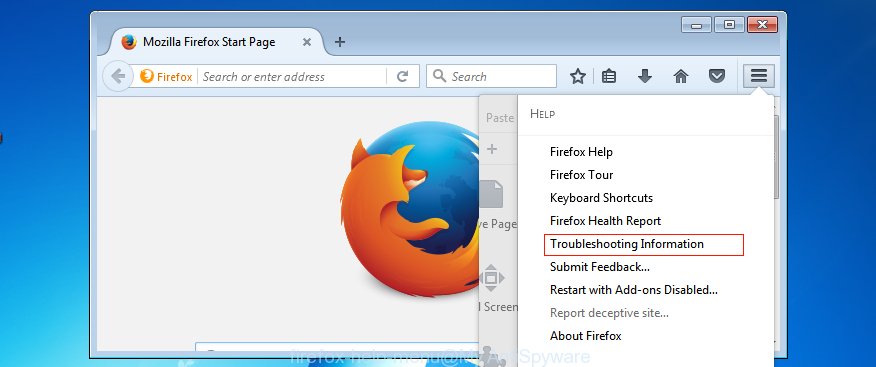
Select the “Troubleshooting information”. If you are unable to access the Help menu, then type “about:support” in your address bar and press Enter. It bring up the “Troubleshooting Information” page as shown on the screen below.
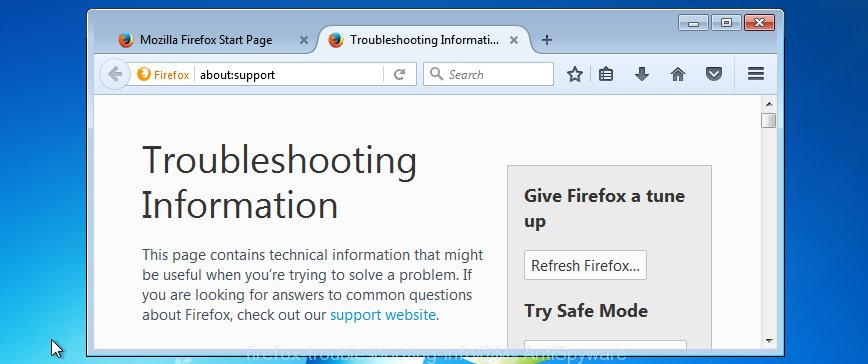
Click the “Refresh Firefox” button at the top right of the Troubleshooting Information page. Select “Refresh Firefox” in the confirmation dialog box. The Mozilla Firefox will start a task to fix your problems that caused by the adware that shows misleading “Network Security Breach” popup on your personal computer. When, it is done, press the “Finish” button.
Remove “Network Security Breach” pop up from Chrome
Like other modern internet browsers, the Chrome has the ability to reset the settings to their default values and thereby recover the internet browser’s settings like start page, new tab page and search provider by default that have been replaced by the adware that causes misleading “Network Security Breach” pop-up on your web-browser.
Open the Google Chrome menu by clicking on the button in the form of three horizontal dotes (![]() ). It will show the drop-down menu. Select More Tools, then press Extensions.
). It will show the drop-down menu. Select More Tools, then press Extensions.
Carefully browse through the list of installed extensions. If the list has the add-on labeled with “Installed by enterprise policy” or “Installed by your administrator”, then complete the following instructions: Remove Chrome extensions installed by enterprise policy otherwise, just go to the step below.
Open the Google Chrome main menu again, click to “Settings” option.

Scroll down to the bottom of the page and click on the “Advanced” link. Now scroll down until the Reset settings section is visible, as displayed on the image below and click the “Reset settings to their original defaults” button.

Confirm your action, press the “Reset” button.
Disinfect the web-browser’s shortcuts to remove “Network Security Breach” redirect
The adware that cause misleading “Network Security Breach” popup to appear, may hijack various Windows shortcuts on your desktop (most often, all web browsers shortcut files), so in this step you need to check and clean them by removing the argument such as http://site.address/.
To clear the internet browser shortcut file, right-click to it and choose Properties. On the Shortcut tab, locate the Target field. Click inside, you will see a vertical line – arrow pointer, move it (using -> arrow key on your keyboard) to the right as possible. You will see a text similar to “http://site.address” which has been added here. You need to delete it.

When the text is removed, click the OK button. You need to clean all shortcut files of all your web browsers, as they may be affected too.
Remove unwanted Scheduled Tasks
If the annoying “Network Security Breach” web-site opens automatically on Windows startup or at equal time intervals, then you need to check the Task Scheduler Library and remove all the tasks which have been created by adware.
Press Windows and R keys on your keyboard at the same time. It will open a prompt that called Run. In the text field, type “taskschd.msc” (without the quotes) and click OK. Task Scheduler window opens. In the left-hand side, click “Task Scheduler Library”, as shown on the screen below.
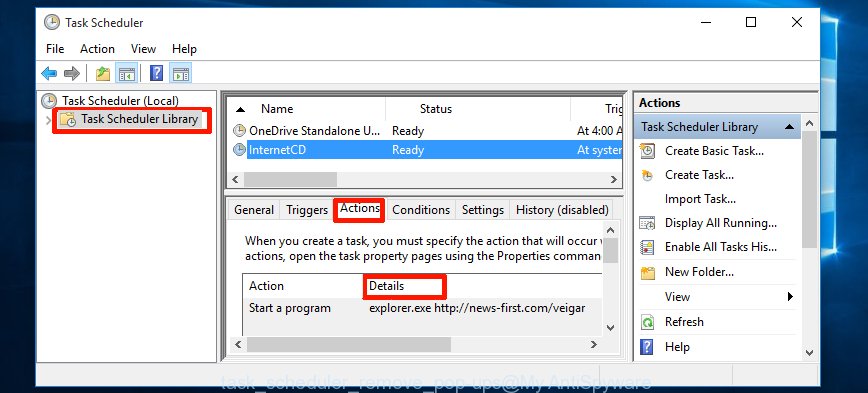
Task scheduler, list of tasks
In the middle part you will see a list of installed tasks. Select the first task, its properties will be show just below automatically. Next, click the Actions tab. Necessary to look at the text which is written under Details. Found something like “explorer.exe http://site.address” or “chrome.exe http://site.address” or “firefox.exe http://site.address”, then you need delete this task. If you are not sure that executes the task, then google it. If it is a component of the ‘ad-supported’ programs, then this task also should be removed.
Further click on it with the right mouse button and select Delete as displayed in the figure below.

Task scheduler, delete a task
Repeat this step, if you have found a few tasks that have been created by adware. Once is done, close the Task Scheduler window.
How to automatically get rid of “Network Security Breach” pop up warnings
The easiest way to remove “Network Security Breach” fake alerts is to run an antimalware application capable of detecting this adware that shows misleading “Network Security Breach” pop-up on your system. We suggest try Zemana Anti-malware or another free malicious software remover that listed below. It has excellent detection rate when it comes to ad supported software, hijackers and other potentially unwanted apps.
Automatically get rid of “Network Security Breach” pop-up with Zemana Anti-malware
Zemana Anti-malware highly recommended, because it can scan for security threats such ‘ad supported’ software and ‘ad supported’ softwares which most ‘classic’ antivirus programs fail to pick up on. Moreover, if you have any “Network Security Breach” popup scam removal problems which cannot be fixed by this utility automatically, then Zemana Anti-malware provides 24X7 online assistance from the highly experienced support staff.

- Download Zemana Anti-Malware on your machine by clicking on the link below.
Zemana AntiMalware
164813 downloads
Author: Zemana Ltd
Category: Security tools
Update: July 16, 2019
- At the download page, click on the Download button. Your web browser will show the “Save as” prompt. Please save it onto your Windows desktop.
- Once the download is done, please close all apps and open windows on your personal computer. Next, launch a file called Zemana.AntiMalware.Setup.
- This will launch the “Setup wizard” of Zemana Anti Malware (ZAM) onto your computer. Follow the prompts and don’t make any changes to default settings.
- When the Setup wizard has finished installing, the Zemana Free will start and display the main window.
- Further, click the “Scan” button to perform a system scan for the ad-supported software which cause misleading “Network Security Breach” fake alerts to appear. While the Zemana Free tool is scanning, you can see how many objects it has identified as being infected by malicious software.
- When the checking is finished, Zemana will display a scan report.
- Review the scan results and then click the “Next” button. The tool will get rid of adware that developed to display misleading “Network Security Breach” fake alerts within your web browser. When the procedure is done, you may be prompted to restart the personal computer.
- Close the Zemana Free and continue with the next step.
Run Malwarebytes to get rid of “Network Security Breach” fake alerts
Remove “Network Security Breach” fake alerts manually is difficult and often the adware is not completely removed. Therefore, we suggest you to run the Malwarebytes Free that are completely clean your personal computer. Moreover, the free program will allow you to delete malware, PUPs, toolbars and browser hijackers that your PC can be infected too.

Visit the following page to download MalwareBytes AntiMalware. Save it directly to your Windows Desktop.
327070 downloads
Author: Malwarebytes
Category: Security tools
Update: April 15, 2020
Once the downloading process is done, run it and follow the prompts. Once installed, the MalwareBytes Anti Malware will try to update itself and when this process is finished, click the “Scan Now” button .MalwareBytes program will scan through the whole PC for the adware that causes multiple misleading “Network Security Breach” alerts and pop-ups. This procedure can take quite a while, so please be patient. While the MalwareBytes AntiMalware (MBAM) utility is scanning, you can see number of objects it has identified as being infected by malware. Review the scan results and then press “Quarantine Selected” button.
The MalwareBytes Anti-Malware is a free application that you can use to remove all detected folders, files, services, registry entries and so on. To learn more about this malicious software removal tool, we advise you to read and follow the step by step instructions or the video guide below.
Scan your machine and remove “Network Security Breach” fake alerts with AdwCleaner
AdwCleaner cleans your PC from browser hijackers, PUPs, unwanted toolbars, web-browser add-ons and other unwanted apps like adware that shows misleading “Network Security Breach” popup on your computer. The free removal utility will help you enjoy your PC system to its fullest. AdwCleaner uses the (c) Malwarebytes technology to detect if there are undesired applications in your personal computer. You can review the scan results, and select the threats you want to uninstall.
Download AdwCleaner by clicking on the link below. Save it to your Desktop.
225545 downloads
Version: 8.4.1
Author: Xplode, MalwareBytes
Category: Security tools
Update: October 5, 2024
Once downloading is finished, open the file location and double-click the AdwCleaner icon. It will start the AdwCleaner tool and you will see a screen as displayed in the following example. If the User Account Control prompt will ask you want to launch the application, click Yes button to continue.
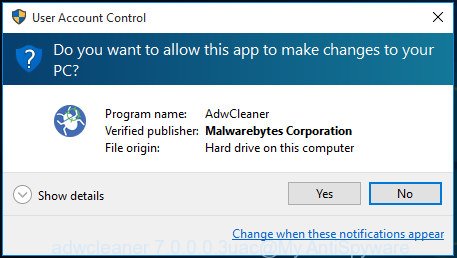
Next, click “Scan” for scanning your computer for the ad supported software which causes misleading “Network Security Breach” pop up warnings on your web browser. This task may take some time, so please be patient. During the scan AdwCleaner will detect threats present on your system.
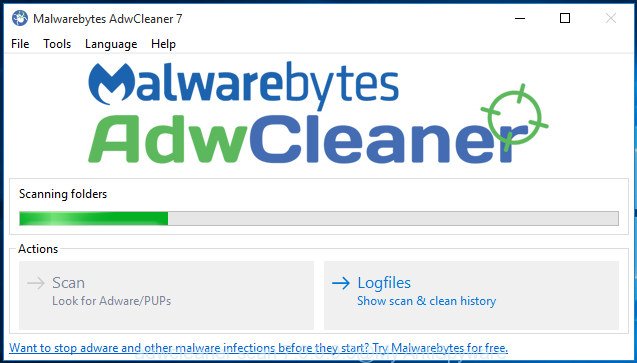
After finished, you may check all items found on your system like below.
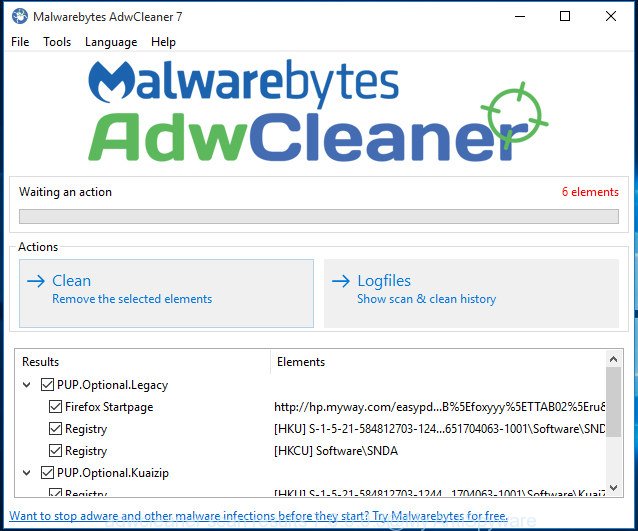
You may move items to Quarantine (all selected by default) by simply click “Clean” button. It will show a prompt. Click “OK” button. The AdwCleaner will delete ad supported software that made to show misleading “Network Security Breach” pop-up warnings within your web browser. When disinfection is complete, the tool may ask you to restart your system. After reboot, the AdwCleaner will display the log file.
All the above steps are shown in detail in the following video instructions.
Block “Network Security Breach” pop-up warnings and other undesired web pages
It is important to run adblocker programs such as AdGuard to protect your machine from harmful web-pages. Most security experts says that it is okay to block advertisements. You should do so just to stay safe! And, of course, the AdGuard may to block “Network Security Breach” and other unwanted web pages.
Installing the AdGuard ad blocker program is simple. First you will need to download AdGuard on your Windows Desktop by clicking on the link below.
26842 downloads
Version: 6.4
Author: © Adguard
Category: Security tools
Update: November 15, 2018
After the download is complete, double-click the downloaded file to run it. The “Setup Wizard” window will show up on the computer screen as displayed on the image below.

Follow the prompts. AdGuard will then be installed and an icon will be placed on your desktop. A window will show up asking you to confirm that you want to see a quick tutorial as shown on the image below.

Click “Skip” button to close the window and use the default settings, or click “Get Started” to see an quick tutorial which will assist you get to know AdGuard better.
Each time, when you start your PC, AdGuard will run automatically and stop pop up advertisements, “Network Security Breach” redirect, as well as other harmful or misleading sites. For an overview of all the features of the program, or to change its settings you can simply double-click on the AdGuard icon, which may be found on your desktop.
How to “Network Security Breach” popup warnings get installed onto personal computer
It is very important to pay attention to additional checkboxes during the setup of free software to avoid installing of PUPs, adware, browser hijacker infections or other unwanted apps. Never install the third-party apps that the application wants to set up with it. Inattentive free software download can result in install of undesired program such as this ‘ad supported’ software that causes misleading “Network Security Breach” popup on your internet browser.
Finish words
Now your machine should be clean of the adware that causes browsers to show misleading “Network Security Breach” fake alerts. Delete AdwCleaner. We suggest that you keep AdGuard (to help you stop unwanted popups and undesired harmful pages) and Zemana Anti-Malware (to periodically scan your PC for new adwares and other malicious software). Probably you are running an older version of Java or Adobe Flash Player. This can be a security risk, so download and install the latest version right now.
If you are still having problems while trying to delete “Network Security Breach” pop up scam from the Internet Explorer, MS Edge, Google Chrome and FF, then ask for help in our Spyware/Malware removal forum.


















